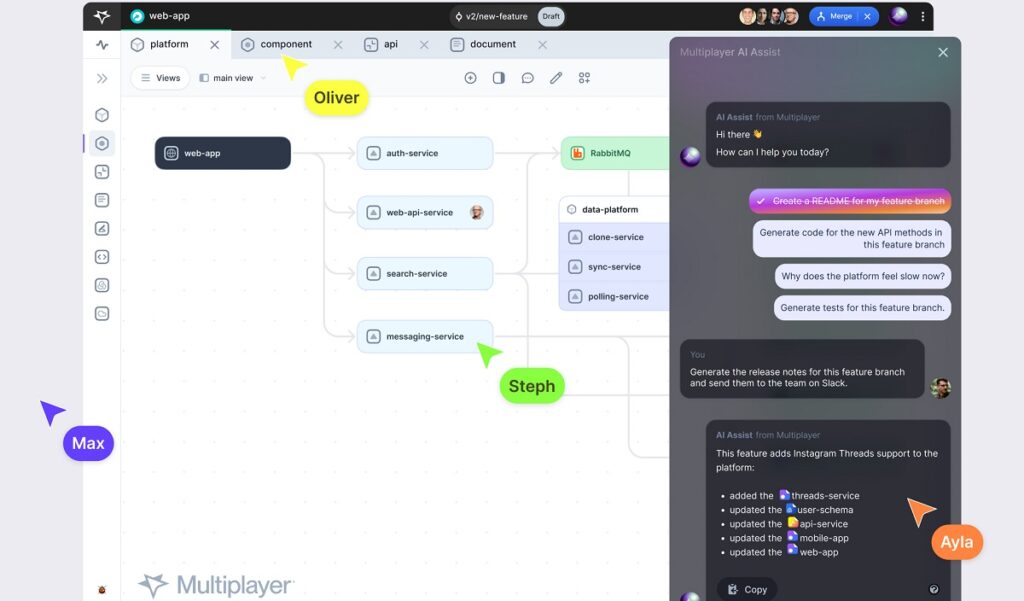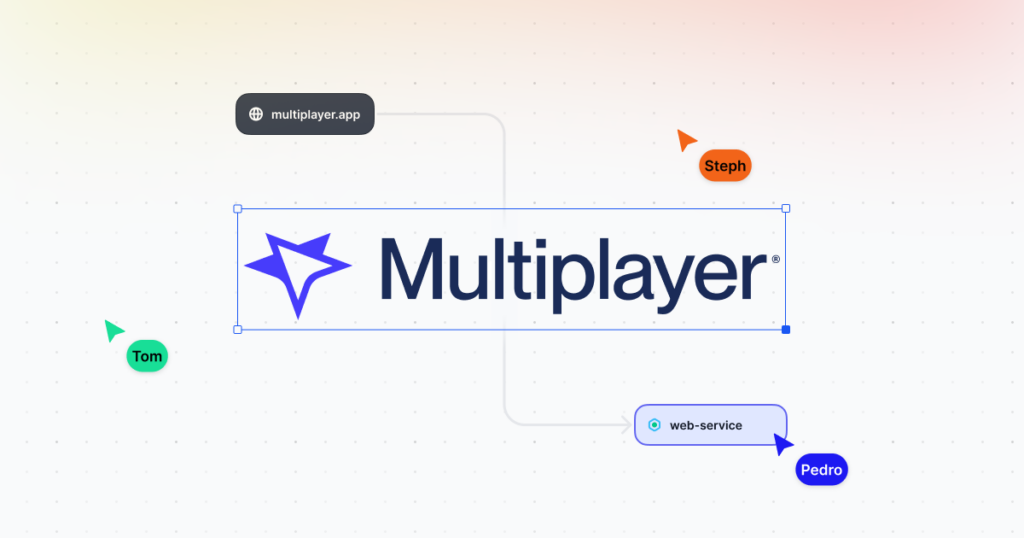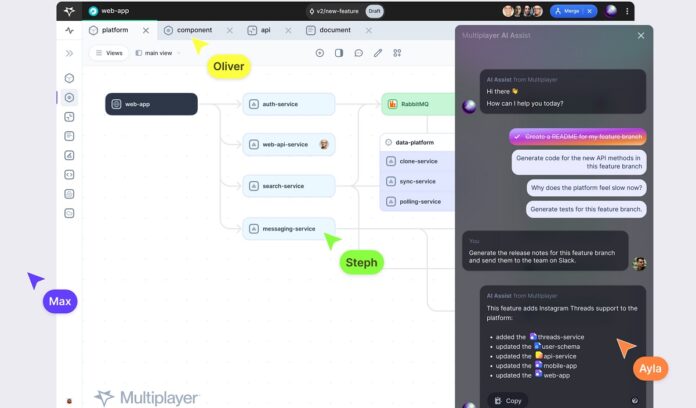Multiplayer, a collaborative development platform for distributed software, recently announced that it has raised $3 million in funding. The platform addresses the needs of teams that work on distributed software, providing a variety of features and tools to streamline the development process and foster effective collaboration. With its visualization of architecture, real-time system dashboard, version control and branching, and integration of AI, Multiplayer aims to help teams build sophisticated software faster.
Collaborative Development Environment
Collaborative development environment (CDE) refers to a space where the needs of entire software teams, which are often dispersed, can be addressed. This concept marked an evolution from tools that focused solely on integrated development environments for individual developers. With the advancement of cloud connectivity, more aspects of the development process can now be handled across distributed environments, while maintaining flexibility and ensuring integration with external services.

Evolution of Development Tools
Over time, the tools used by development teams have evolved to meet the changing needs of distributed software development. Traditional solutions such as physical whiteboards or makeshift diagramming tools have been used to visualize complex system architectures. However, these outdated methods lack the specific functionality required for effective collaboration and communication. Multiplayer seeks to fill this gap in the market by providing a dedicated platform that brings together all the necessary elements of backend software development.
Benefits of Cloud Connectivity
Cloud connectivity has revolutionized the way software development teams operate. It enables developers to work across dispersed environments without creating siloes, ensuring the integrity of the development process. This flexibility also allows for seamless integration with external services, which are now an integral part of modern software. With the benefits of cloud connectivity, teams are able to collaborate more effectively and build robust distributed environments.
About Multiplayer
Multiplayer is a collaborative development platform that addresses the needs of teams working on distributed software. Built by developers themselves, the platform offers a range of features and tools to support effective collaboration and streamline the development process.
Development Collaboration Platform
At its core, Multiplayer provides a visualization of architecture at a holistic level in real-time. This visualization serves as a system dashboard, allowing teams to collaborate, convey design intent, and ensure version control and branching. Previously, these critical functions would need to be performed individually and across disparate tools, often causing a bottleneck in the development process.
Addressing the Needs of Distributed Software Teams
Multiplayer was specifically designed to cater to the needs of teams that work on distributed software. By providing a comprehensive set of features and tools, the platform enables efficient collaboration and streamlines the development process. With its focus on addressing the unique challenges faced by distributed software teams, Multiplayer aims to improve productivity and foster effective communication.
Visualization of Architecture
One of the key features of Multiplayer is its ability to visualize system architecture at both a high level and in detail. This allows teams to gain a comprehensive understanding of the entire system, as well as specific features and changes. By providing detailed visualizations in real-time, Multiplayer helps teams identify potential issues and make informed decisions.
Real-time System Dashboard
The system dashboard in Multiplayer provides teams with a centralized space for collaboration. It enables real-time communication, allowing team members to share ideas, provide feedback, and make updates. The dashboard serves as a hub for all team activities, keeping everyone on the same page and ensuring efficient collaboration.
Collaboration and Design Intent
Multiplayer facilitates collaboration by allowing teams to convey design intent effectively. By pulling together multiple document types, such as platform diagrams, APIs, sketches, and source code, teams can clearly communicate their design decisions. This ensures that everyone involved in the development process has a shared understanding of the project goals and objectives.
Version Control and Branching
Version control and branching are essential for managing the development process and keeping track of changes. Multiplayer offers robust version control capabilities, allowing teams to track and manage code changes effectively. By providing branching functionality, teams can work on different features or bug fixes simultaneously, without interfering with each other’s work.
Repository for Recording Actions
Multiplayer serves as a repository where all actions are recorded, providing a comprehensive history of the development process. This allows teams to track changes, review past decisions, and understand the evolution of the project. The repository ensures transparency and accountability within the team, promoting effective collaboration and knowledge sharing.
Integration of AI
To streamline the development process further, Multiplayer has integrated AI capabilities. AI automation helps automate various aspects of documentation and service integrations. This saves time and reduces manual effort, allowing teams to focus on more critical tasks. By leveraging AI, development teams can create robust distributed environments without sacrificing any necessary steps.
Automation of Documentation and Service Integrations
Documentation is crucial for software development projects, but it can be time-consuming to create and maintain. Multiplayer’s AI capabilities automate documentation generation, ensuring that teams have up-to-date and accurate documentation at all times.
Additionally, Multiplayer offers service integrations, making it easier for teams to seamlessly connect with external services. By automating these integrations, Multiplayer eliminates manual effort and ensures the smooth operation of complex software ecosystems.
Chat Functionality for Knowledge and Analytics
Communication is essential for effective collaboration, and Multiplayer provides chat functionality to facilitate knowledge sharing and analytics. Team members can communicate and exchange ideas in real-time, ensuring that everyone is on the same page. The chat functionality also enables teams to track and analyze their conversations, providing valuable insights for future decision-making.
Design Support
Multiplayer offers design support by generating software components using AI. This feature saves time and enables teams to focus on higher-level design decisions. By automating the generation of software components, Multiplayer promotes faster development cycles and reduces the risk of errors.

Investors and Funding
The recent funding round of $3 million was led by Bowery Capital, with participation from Okapi Venture Capital, Mitch Wainer (cofounder of DigitalOcean), and Edith Harbaugh (founder of LaunchDarkly). These investors recognized the potential of Multiplayer’s collaborative development platform and its ability to address the needs of distributed software teams.
Product or Service Offered
Multiplayer offers a collaborative tool for teams working on distributed software. The platform fills a gap in the market by providing features and functionality specifically designed for backend software development.
Filling a Gap in the Market
Until now, development teams have relied on outdated or makeshift solutions for collaboration on backend software design. Physical whiteboards or poor diagramming tools were commonly used, but they lacked the necessary capabilities for effective collaboration. Multiplayer aims to fill this gap by offering a platform that provides all the required elements of backend software development.
Visualization of System Architecture
One of the key features of Multiplayer is its ability to visualize system architecture. Teams can get a holistic view of the entire system, as well as detailed views of specific features and changes. This comprehensive visualization helps teams understand the complexity of the software and make informed decisions.
Detailed Views and Real-time Changes
Multiplayer enables detailed views of specific features and changes in real-time. This allows teams to closely examine different parts of the system architecture and identify potential issues or improvements. Real-time changes ensure that teams are always working with the latest information and can respond quickly to any updates.
Communication of Design Intent
Effective communication of design intent is crucial for successful software development. Multiplayer allows teams to communicate their design decisions clearly by pulling together multiple document types, such as platform diagrams, APIs, sketches, and source code. This ensures that all team members have a shared understanding of the project goals and can work towards them effectively.
Formal Design Reviews
Multiplayer facilitates formal design reviews, allowing all stakeholders, including team leads, developers, QA, CTOs, and DevOps, to provide feedback before moving to implementation. This ensures that potential issues are addressed early in the development process, reducing the risk of costly errors and rework.
Real-time Team Collaboration
Multiplayer fosters real-time team collaboration, similar to popular frontend platform Figma. Teams can collaborate seamlessly, regardless of their physical location or time zone. This promotes effective collaboration, knowledge sharing, and ensures that all team members are aligned towards project goals.
AI-generated Software Components
Multiplayer leverages AI to generate software components, such as system architectures, APIs, service implementations, and Infrastructure as Code (IaC). This automation saves time and reduces manual effort, allowing teams to focus on higher-level design decisions. By automating the generation of software components, Multiplayer helps teams build robust distributed environments efficiently.

Inspiration for Multiplayer
The inspiration for Multiplayer came from the identification of a gap in the marketplace. Cofounder/CTO Tom Johnson, a long-time developer, noticed that developers of complex distributed software systems were using outdated solutions like whiteboards and makeshift diagramming tools. He saw the need for a dedicated backend tool similar to the popular frontend platform Figma. This realization prompted the creation of Multiplayer.
Differentiation of Multiplayer
Multiplayer stands out from other platforms because it brings together all the elements of backend software development in one platform. While there are tools available for various aspects of software development, such as version control or collaboration, Multiplayer combines them into a comprehensive solution. This integration of backend software development elements, along with its collaborative and communicative capabilities, sets Multiplayer apart from other tools in the market.

Target Market and Size
Multiplayer targets software developers and teams working on distributed software. With an estimated 28 million software developers worldwide, the potential market for Multiplayer is significant. The platform will be priced per user per month, with other roles such as QA, DevOps, and product managers also being potential users. The addressable market for Multiplayer is vast, encompassing a wide range of software development teams.
Favorite Summer Destination
On a lighter note, the favorite summer destination of the Multiplayer team is the North Fork of Long Island, specifically Southold. They enjoy the relaxed atmosphere, great food, wineries, and beautiful beaches in this area. Even software developers need a break from coding to recharge and enjoy the summer!
In conclusion, Multiplayer’s collaborative development platform offers a comprehensive solution for teams working on distributed software. With its visualization of architecture, real-time system dashboard, collaboration features, and integration of AI, Multiplayer aims to streamline the development process and foster effective teamwork. With a recent funding round of $3 million and a strong focus on addressing the needs of software development teams, Multiplayer is poised for success in the market.





